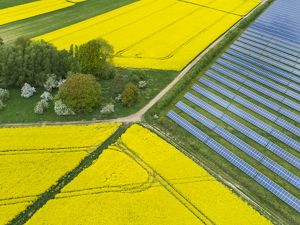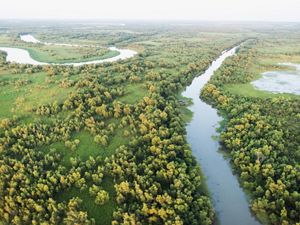A Better Blueprint for the Clean Energy Landscape
How do we meet global clean energy goals while protecting natural lands?
Shifting to a clean energy economy is critical for a sustainable future. But this transformation presents its own set of environmental risks. A business-as-usual approach to siting new energy infrastructure could undermine environmental progress by converting natural lands that currently protect biodiversity and serve as a critical natural climate solution—keeping carbon stores locked in vegetation.
But there is a better way. Research from The Nature Conservancy (TNC) shows we can meet clean energy goals 17 times over without disrupting natural lands. This research has been integrated into a tool designed to demonstrate how converted lands can provide lower-conflict solutions for the deployment of new renewable energy installations.
Tool: Global Clean Energy Potential
Manipulate inputs to see what regions of the world have the most potential to generate clean energy, and where development would have the greatest impacts to natural lands, including loss of biodiversity and natural carbon storage.
A win-win for climate and biodiversity goals
Globally, converted lands encompass more than 6 million square kilometers of settled areas, agricultural lands, mine sites, roads and other transformed lands that are also suitable for renewable energy development. Steering new development toward these locations can relieve pressure on intact lands that make invaluable contributions to the health of the planet.
As clean energy needs to rapidly expand, the aggregated area of natural lands under threat is projected to rival Iceland in size. Collectively, this area represents wildlife habitats as diverse as that of the sage grouse in the North American grasslands and the snow leopard of Central Asia. To blaze the path to our clean energy future through these territories would ultimately slow our advancement toward the goals laid out in the 2015 Paris Agreement.
Minimizing clean energy investment risk
That said, it is essential that we agree upon a concrete and collaborative prescription to accelerate a smart transition to clean energy. Here’s why: Clean energy infrastructure projects face a financing gap of more than $28 trillion. Only the scale of capital held by large institutional investors such as pension, insurance and sovereign wealth funds can close that gap.
Yet clean energy infrastructure projects have long occupied a higher risk investment category. Policies that create clean energy zones on already converted lands can minimize investment risk and spur the major private investment required to fill the investment gap and, ultimately, bring our targets within reach.
Global Insights
Check out our latest thinking and real-world solutions to some of the most complex challenges facing people and the planet today.



